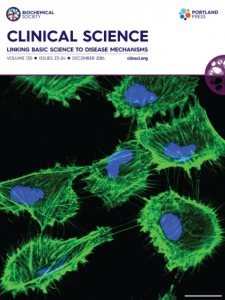 A journal has retracted a 2011 study at the request of Columbia University.
A journal has retracted a 2011 study at the request of Columbia University.
According to Jeanine D’Armiento, the study’s last author, the newly retracted paper in Clinical Science contained a figure from a Journal of Hypertension paper published by the same authors earlier that year.
First and corresponding author Joseph George told Retraction Watch the error was unintentional. A Columbia spokesperson sent us this statement:
The University investigated concerns raised about this paper in accordance with University policy and ultimately recommended that the paper be retracted. We regret that a request to retract a paper involving University research had to be made.
Here’s the retraction notice:
Following an investigation by the Columbia University Office of Research Compliance and Training, the Editorial Board of Clinical Science is upholding the recommendation to retract this paper that has been communicated by the University’s Standing Committee on the Conduct of Research. All authors on the paper have been contacted with regard to the retraction.
The September 2011 paper, “Transgenic expression of human matrix metalloproteinase-1 attenuates pulmonary arterial hypertension in mice,” has been cited seven times, according to Clarivate Analytics’ Web of Science, formerly part of Thomson Reuters.
The paper that originally published the image in question, “Transgenic expression of human matrix metalloproteinase-9 augments monocrotaline-induced pulmonary arterial hypertension in mice,” was published in February 2011, and has been cited 10 times.
George — now based at Kanazawa Medical University in Ishikawa, Japan — told us:
This is an absolute misunderstanding of the Figure legend by the investigation committee and not falsification or research misconduct. I had only six samples (6 mice in each group) and as per our protocol, I need to put only the mean value of 6 samples and not 10. In order to make the results more accurate, I scanned each slide under a microscope using image quantification software, loaded the images to a computer and quantified. In most slides, there were 10 or more clear fields, but in 1 or 2 slides it was only 8 or 9 fields. Therefore, the statement 10 randomly selected microscopic fields in the Figure legend is mean of 8-12 fields. I did not use the word mean there because it will confuse whether the mean stated is for 6 samples or 8-12 fields. I also did not write as 8-12 fields because I cannot write the details that which slide is 8 or 9 fields and which one is 11 or 12 fields. Anyone who works on this field will understand that this is not falsification, fabrication, or research misconduct. I am not going to achieve anything with this statement in the paper and I cannot get the paper published because I wrote like that. This is nothing but a silly writing error. I explained everything in details what I did in my research to the investigation committee. This could easily correct by publishing an erratum as 8-12 fields instead of 10 in the legend of Figure 5.
George added that the investigation committee
…asked only data for Figure 5 and not for any other Figures or portions in the manuscript. I have provided them 6 sets of images in each group and I can provide the same again to Clinical Science. The committee demanded to produce a total of 240 images for Figure 5 (10 per sample x 4 sets x 6 mice per group). That is 60 images in each group. They did not understand that there were not 60 images in each group and the 60 fields stated are used only for image quantification on a microscope. This happened because none of the committee members has knowledge about image quantification and how to carry out the same.
The data weren’t fabricated, agreed D’Armiento, claiming that she’d seen the original version with her own eyes. D’Armiento called the issue a “mix-up,” noting that the data were not under question.
We asked Clinical Science if all the authors had agreed to the retraction, but a representative of the journal referred us to the authors. George told us he disagreed with the decision:
I requested Clinical Science do not retract our quality publication and instead publish an erratum with revised Figure legend. A publication should be retracted only when there is clear and strong evidences of falsification and misconduct, which affected overall outcome of the results and conclusion of the work and the same must be clearly stated with evidences on the retraction note.
D’Armiento agreed that the error did not affect the study’s findings. The Journal of Hypertension paper will not be retracted, she added, since it was published first.
We’ve also found a corrigendum for a 2009 paper that lists D’Armiento as last author, which substitutes an incorrect figure and legend with correct versions.
Like Retraction Watch? Consider making a tax-deductible contribution to support our growth. You can also follow us on Twitter, like us on Facebook, add us to your RSS reader, sign up on our homepage for an email every time there’s a new post, or subscribe to our daily digest. Click here to review our Comments Policy. For a sneak peek at what we’re working on, click here.
Nice to see that Columbia’s committee contacted the journal directly — and, judging from the retraction notice, provided helpful information. That makes the journal’s job so much easier. Sadly, outside the US, such cooperation is rare.